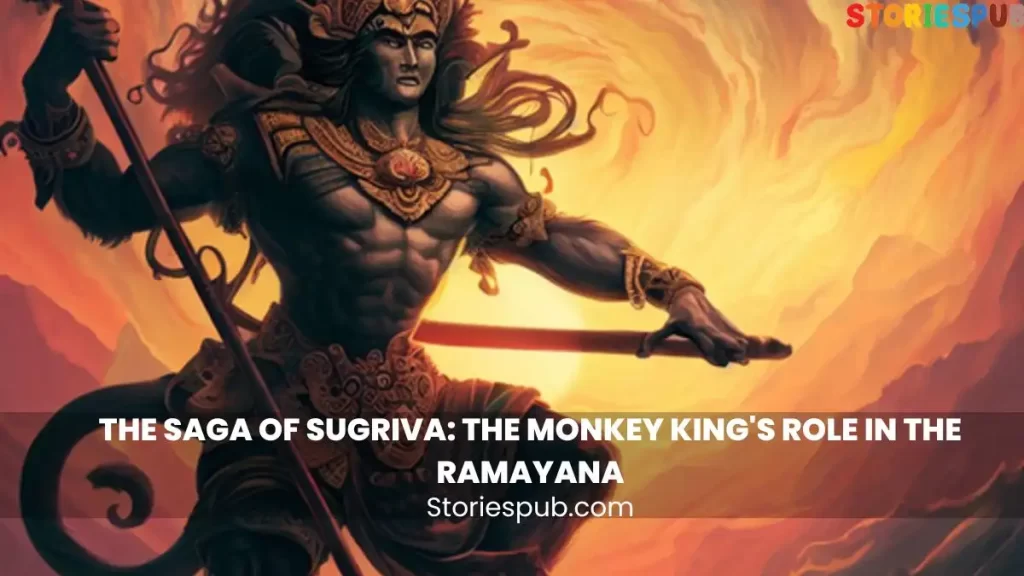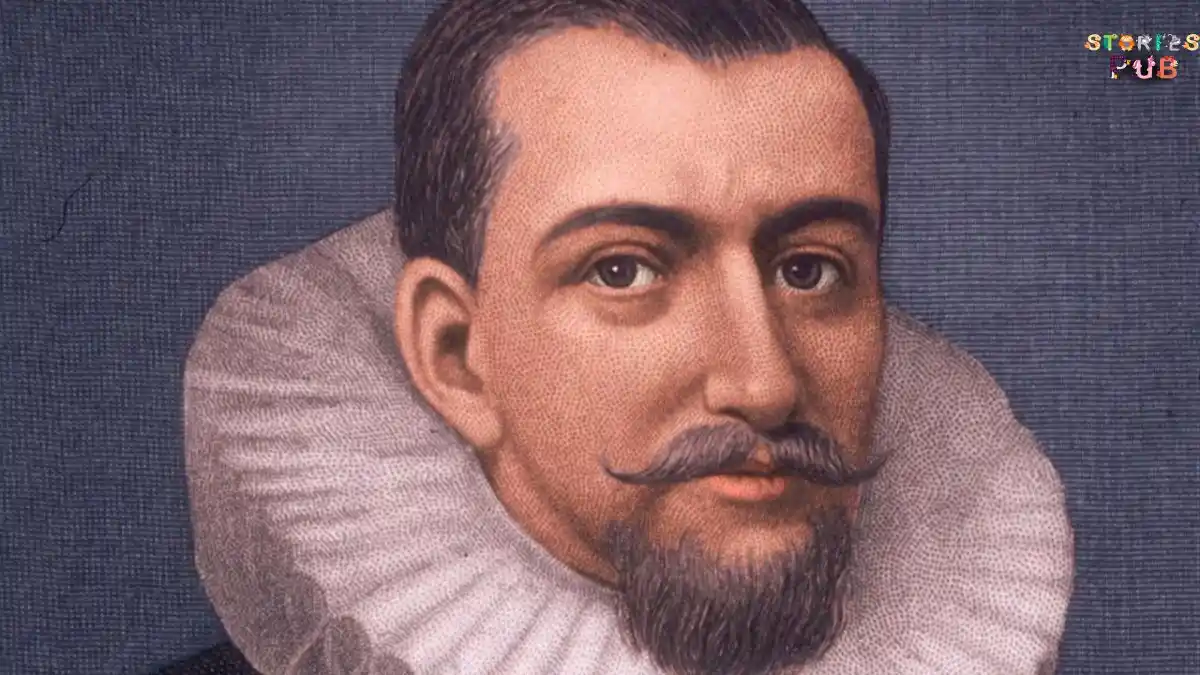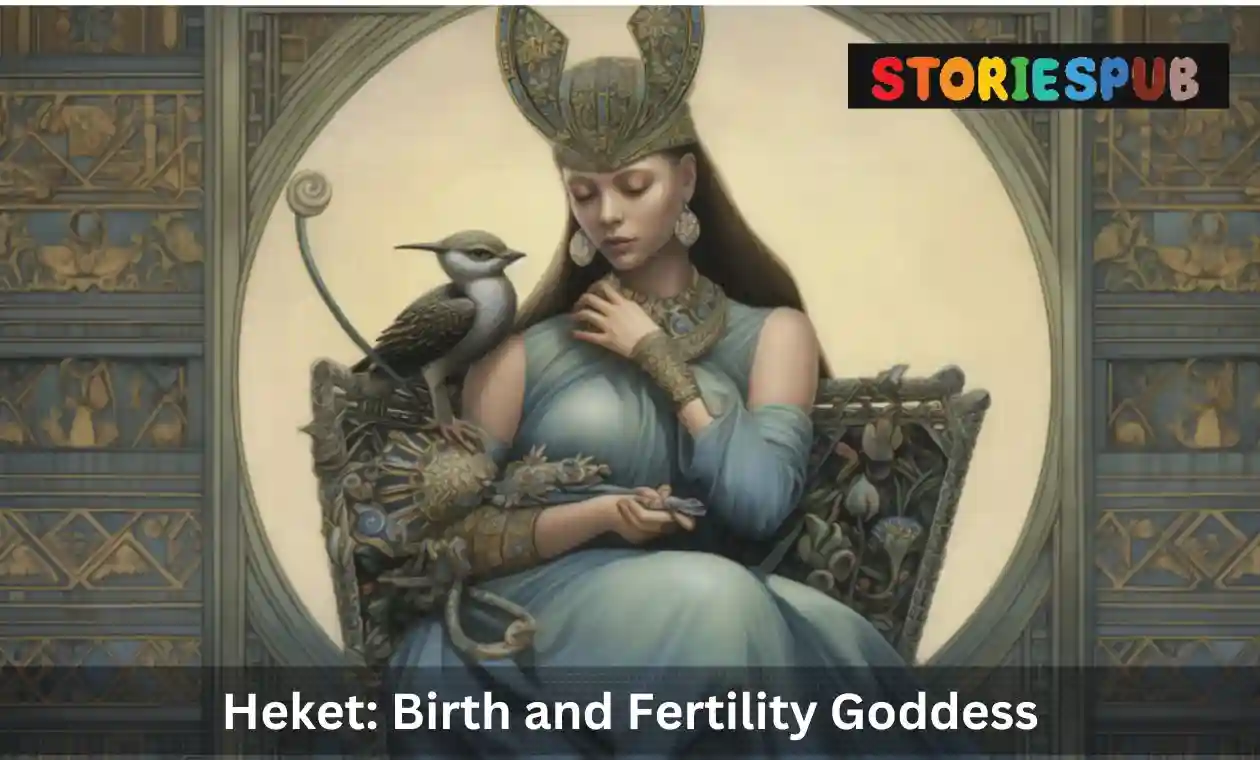Summarize this Article with:
The Saga of Sugriva: The Monkey King’s Role in the Ramayana

Bali (also known as Vali) and Sugriva were born in the Vanara race, a group of powerful and skilled monkey-like beings that played a crucial role in the Ramayana. Their father, Surya, the Sun God, was married to Indra’s daughter. Surya’s wife gave birth to Vali, while another woman in the form of a monkey bore Sugriva. Despite their different mothers, they were raised as brothers and shared a close bond.
Family Background: The brothers were born with divine powers, as their father was a deity, and their mother was a daughter of Lord Indra. They were raised to be strong and wise rulers, guided by their innate wisdom and virtue. They received their education from the great sage Matanga and learned essential life lessons, which prepared them to lead their kingdom.
Brothers and rulers of Kishkindha:
In the beginning, Sugriva and Vali shared a strong brotherly bond that played a crucial role in their collaborative rule over the kingdom of Kishkindha. As sons of the Sun God, Surya, they were both endowed with remarkable strength and power, which they used to protect their kingdom and maintain order among their subjects.
As co-rulers, they complemented each other’s strengths and worked in harmony to ensure that Kishkindha flourished. They focused on good governance, the welfare of their citizens, and the defense of their kingdom against external threats. This strong partnership between the brothers earned them the respect and admiration of their subjects, who prospered under their leadership.
This bond also extended to their military prowess, where they jointly defended Kishkindha from various demons and enemies. Together, they led their monkey army with great skill and valor, ensuring peace and stability in their kingdom. It was this combined strength and unity that made Sugriva and Vali a powerful and celebrated duo in their early years.
However, their close relationship would eventually be marred by suspicion and conflict, resulting in a tragic series of events that would change the course of their lives and the destiny of Kishkindha forever. Despite the initial unity and success of their partnership, the story of Sugriva and Vali serves as a cautionary tale about the fragility of trust and the consequences of misunderstandings between even the closest of siblings.
Conflict and Sugriva’s exile:
Unexpectedly, Vali emerged victorious from the cave after a long battle with the demon Mayavi. On discovering that the entrance had been sealed, Vali felt a deep sense of betrayal, as he thought Sugriva had intentionally trapped him in the cave to usurp the throne of Kishkindha. Consumed by anger, Vali jumped to conclusions, refusing to consider any alternative explanations for Sugriva’s actions.
Sugriva, on the other hand, had been genuinely concerned for his brother’s life and had acted in accordance with Vali’s instructions. Devastated by the turn of events and heartbroken by Vali’s accusations, Sugriva tried to explain his actions, but to no avail. Vali’s fury knew no bounds, and he refused to listen to reason.
In a fit of rage, Vali banished Sugriva from Kishkindha, stripping him of his rights and status as a prince. As if this humiliation wasn’t enough, Vali took Sugriva’s wife, Ruma, as his own, further adding to Sugriva’s misery. Forced into exile and utterly alone, Sugriva sought refuge at the Rishyamukha Mountain, where he would eventually meet Hanuman, who would become his most loyal friend and ally.
The story of the conflict between Sugriva and Vali is a tragic tale of misunderstandings and the devastating consequences that can arise from a lack of trust and communication. As the brothers allowed their bond to crumble, their once-thriving kingdom and family would face strife and turmoil.
Alliance with Lord Rama
When Lord Rama and his brother Lakshmana arrived at Rishyamukha Mountain during their search for Rama’s abducted wife, Sita, destiny brought them together with Sugriva. At that time, Sugriva was living in exile with his loyal follower, Hanuman. Hanuman, who had been keeping a watchful eye on the area, saw Rama and Lakshmana and recognized their divine nature. He brought them to Sugriva, initiating a fateful meeting that would forever change the lives of all involved.
As Sugriva listened to Rama’s story, he found a common ground in their shared experiences of loss and betrayal. In return, Sugriva shared his own tragic tale of exile, expressing his longing to regain his kingdom and restore his honor. Seeing an opportunity for mutual benefit, Sugriva and Lord Rama formed an alliance. They vowed to help each other: Rama would assist Sugriva in defeating Vali and reclaiming his throne, while Sugriva would help Rama find Sita and defeat the demon king Ravana.
To solidify their pact, Sugriva and Lord Rama performed a traditional fire ceremony, pledging their loyalty and friendship to one another. This alliance marked the beginning of a profound bond between the two, founded on trust, loyalty, and a shared commitment to justice.
Vali’s death at the hands of Lord Rama
The death of Vali at the hands of Lord Rama is a significant event in the Ramayana, as it facilitated Sugriva’s return to power and the subsequent search for Sita. Once Sugriva had formed an alliance with Rama, they devised a plan to challenge Vali and reclaim the throne of Kishkindha.
As part of their strategy, Sugriva engaged Vali in combat, while Rama positioned himself at a distance with his bow and arrows, ready to strike when the opportunity presented itself. Vali, being the stronger of the two brothers, had the upper hand in the battle, causing Sugriva to struggle. At this critical moment, Rama aimed his arrow and shot Vali from afar.
Mortally wounded, Vali fell to the ground, and the true nature of the situation was revealed. He questioned Rama’s actions, arguing that as a righteous and virtuous prince, Rama should not have killed him without a fair trial. Rama explained that Vali had committed several injustices, including banishing his brother, taking Sugriva’s wife, and disrupting the harmony in Kishkindha. As a protector of dharma, or cosmic order, Rama was justified in his actions.
As Vali lay dying, he began to accept Rama’s wisdom and acknowledged his mistakes. He requested Rama to look after his wife, Tara, and to protect Sugriva in the future. Rama, honoring Vali’s last wishes, ensured that Tara and Sugriva were cared for and that Kishkindha would have a peaceful transition of power.
Vali’s death marked the end of a tumultuous period for Kishkindha and paved the way for Sugriva to regain his throne, honor, and wife. It also strengthened the bond between Sugriva and Rama, allowing them to focus their energies on rescuing Sita and defeating Ravana. The episode of Vali’s death in the Ramayana serves as a powerful reminder of the importance of righteousness, trust, and loyalty.
Sugriva’s crowning as the king
With Vali’s death and Lord Rama’s support, Sugriva was finally able to reclaim his rightful place as the king of Kishkindha. As the Vanaras of Kishkindha gathered to witness the momentous occasion, Rama performed the coronation ceremony, placing the royal crown on Sugriva’s head. This marked the beginning of a new era for the kingdom, one that would be characterized by wisdom, righteousness, and unity.
Sugriva’s ascent to the throne signified not only the restoration of his personal honor but also the fulfillment of his promise to Lord Rama. As the newly-crowned king, Sugriva was now in a position to mobilize the Vanara army to aid Rama in his quest to rescue Sita from the clutches of the demon king Ravana.
Under Sugriva’s rule, Kishkindha returned to a state of peace and prosperity. He governed with fairness and wisdom, healing the rifts caused by the earlier conflict between him and Vali. Moreover, Tara, Vali’s wife, played a crucial role in providing guidance and support, allowing Sugriva to establish a strong and stable rule over Kishkindha.
The Role of Hanuman in Sugriva’s Life
Hanuman, a key character in the Ramayana, played an essential role in Sugriva’s life. His unwavering loyalty, wisdom, and strength had a profound impact on Sugriva’s journey, from his time in exile to his eventual rise as the king of Kishkindha.
Friend and confidant in exile: Hanuman first met Sugriva while the latter was living in exile on Rishyamukha Mountain. Hanuman, recognizing Sugriva’s noble nature, pledged his allegiance and friendship to him. He provided Sugriva with companionship, support, and counsel during this difficult period.
Introduction to Lord Rama: When Lord Rama and Lakshmana arrived at Rishyamukha Mountain searching for Sita, it was Hanuman who brought them to Sugriva. This fateful encounter led to the formation of an alliance between Rama and Sugriva, setting the stage for a series of events that would change their destinies.
Hanuman’s search for Sita: Once Sugriva reclaimed his throne, he fulfilled his promise to help Lord Rama find Sita. Hanuman played a critical role in this endeavor, using his incredible strength, intelligence, and shape-shifting abilities to locate Sita in the demon king Ravana’s palace on the island of Lanka.
Role in the battle against Ravana: Hanuman not only provided valuable information about Sita’s whereabouts but also played a crucial role in the battle against Ravana. He served as a formidable warrior and strategist, rallying the Vanara army and helping to defeat Ravana’s forces, ultimately leading to Sita’s rescue and Rama’s victory.
Post-war: After the war against Ravana, Hanuman continued to serve Sugriva loyally, providing support, guidance, and protection to the king and the people of Kishkindha.
The bond between Sugriva and Hanuman is an enduring testament to the power of loyalty, friendship, and selflessness. Hanuman’s unwavering support, bravery, and wisdom were invaluable assets to Sugriva, enabling him to overcome adversity, reclaim his throne, and ultimately fulfill his dharma. The story of Hanuman and Sugriva highlights the importance of true friendship and the profound impact it can have on one’s life.
Mobilizing the monkey army
Once Sugriva was crowned as the king of Kishkindha, it was time for him to uphold his end of the bargain with Lord Rama by helping him find Sita and defeat Ravana. To accomplish this, Sugriva needed to mobilize the vast and powerful monkey army that resided in Kishkindha.
Sugriva called upon the Vanaras, his loyal subjects, and explained the gravity of the situation. He shared the story of Sita’s abduction by Ravana and the alliance with Lord Rama to rescue her. The Vanaras, inspired by Sugriva’s leadership and their duty to support their king, pledged their allegiance to the cause.
To maximize their chances of success, Sugriva divided the Vanara army into four groups, each led by a capable commander, and assigned them to search for Sita in different directions – north, south, east, and west. Hanuman, known for his wisdom, strength, and intelligence, was appointed as the leader of the group heading south.
As the search for Sita commenced, the Vanaras scoured the earth, overcoming numerous obstacles and challenges along the way. Their perseverance and dedication eventually paid off when Hanuman discovered Sita in Ravana’s palace on the island of Lanka. Armed with this vital information, the monkey army regrouped and prepared to support Rama in the battle against Ravana and his forces.
The mobilization of the monkey army by Sugriva demonstrates the importance of strong leadership, unity, and a clear sense of purpose. The unwavering commitment of the Vanaras to their king and their cause played a crucial role in the ultimate victory against Ravana, rescuing Sita and restoring peace and balance to the world. The story of the monkey army serves as a powerful reminder of the strength that comes from loyalty, teamwork, and determination in the face of adversity.
Sugriva’s Life After the War Against Ravana
After the war against Ravana and the successful rescue of Sita, Sugriva returned to Kishkindha to continue his rule as the king of the Vanaras. With peace and stability restored, he focused on governing with wisdom, fairness, and compassion, ensuring the prosperity and well-being of his subjects.
Under Sugriva’s rule, Kishkindha flourished, with its people enjoying the fruits of their loyalty and bravery. Sugriva’s friendship with Lord Rama remained strong, with both leaders continuing to support and respect each other. Hanuman, the loyal and powerful ally, continued to serve Sugriva and Kishkindha with dedication.
Sugriva’s life after the war against Ravana was marked by a newfound appreciation for the importance of righteousness, loyalty, and the bonds of friendship. He had experienced firsthand the transformative power of these virtues, which had allowed him to overcome adversity, reclaim his throne, and play a crucial role in the defeat of Ravana.
Sugriva’s life story in the Ramayana serves as an inspiring example of redemption, personal growth, and the power of true friendship. His journey from exile to a righteous king, his unwavering commitment to his allies, and his role in the victory over Ravana stand as a testament to his character and the enduring significance of his story in the epic of the Ramayana.
Lasting lessons from Sugriva’s story
Sugriva’s story in the Ramayana is one of redemption, personal growth, and the power of friendship, offering several lasting lessons that remain relevant and inspiring even today:
Importance of loyalty and friendship: Sugriva’s alliance with Lord Rama and his friendship with Hanuman underscore the value of trust and loyalty in relationships. True friends stand by each other through adversity, offering support and encouragement when it is needed the most.
Power of redemption and personal growth: Sugriva’s story demonstrates that even in the face of adversity, one can find redemption and change for the better. His journey from exile to the righteous king shows that it is never too late to learn from past mistakes and grow as an individual.
The strength of unity and teamwork: The mobilization of the monkey army and their unwavering commitment to their king and cause highlight the strength that comes from unity and teamwork. By working together, individuals can overcome obstacles and achieve remarkable feats.
Righteousness and dharma: Sugriva’s story emphasizes the importance of upholding dharma, the cosmic order, and righteousness in one’s actions. By aligning with what is morally right and just, one can bring about positive change and restore harmony to the world.
The significance of forgiveness and understanding: Sugriva’s journey teaches the value of forgiveness and understanding, both towards oneself and others. By letting go of past grievances, accepting responsibility for one’s actions, and seeking to understand others’ perspectives, lasting peace and growth can be achieved.
Sugriva’s story in the Ramayana serves as a timeless reminder of the power of loyalty, friendship, and personal growth. These lessons, embedded within the epic, continue to resonate with and inspire generations of readers across the world.
In conclusion, the story of Sugriva, the Monkey King, in the Ramayana is an inspiring tale that showcases the significance of loyalty, friendship, and personal growth. Through his journey from exile to becoming the king of Kishkindha, Sugriva exemplifies the importance of unity, teamwork, righteousness, and forgiveness.
Sugriva’s alliance with Lord Rama and his friendship with Hanuman not only played a crucial role in the defeat of Ravana and the rescue of Sita but also served as a testament to the transformative power of strong bonds and unwavering commitment to one’s friends and allies.
As an integral part of the Ramayana, Sugriva’s story continues to resonate with generations of readers, offering valuable lessons that remain relevant even today. The timeless wisdom embedded in his journey serves as a powerful reminder of the importance of staying true to our values, learning from our past, and cherishing the bonds we forge along the way.
Saga of Sugriva FAQ
Who is Sugriva in the Ramayana?
Sugriva is a central character in the Ramayana, known as the Monkey King who ruled Kishkindha. He plays a crucial role in helping Lord Rama find Sita and defeat Ravana
What is the relationship between Sugriva and Vali?
Sugriva and Vali were brothers and rulers of Kishkindha. They had a close bond until a misunderstanding led to conflict and Sugriva's exile.
How did Sugriva become the king of Kishkindha?
Sugriva became king after Vali's death at the hands of Lord Rama, with whom Sugriva formed an alliance. Rama then crowned Sugriva as the king of Kishkindha.
How did Sugriva help Lord Rama?
Sugriva assisted Lord Rama by mobilizing the monkey army to search for Sita and later supporting Rama in the battle against Ravana.
What is the story behind Sugriva's exile?
Sugriva's exile was due to a misunderstanding with his brother Vali, who believed Sugriva betrayed him. Vali banished Sugriva and seized the throne.
Who killed Vali in the Ramayana?
Vali was killed by Lord Rama, who intervened in a confrontation between Sugriva and Vali, shooting Vali with a fatal arrow.
What role did Hanuman play in Sugriva's life?
Hanuman was a loyal friend and confidant to Sugriva, providing companionship during his exile, helping forge an alliance with Lord Rama, and playing a crucial role in the search for Sita.
How did Sugriva and Lord Rama become allies?
Sugriva and Lord Rama became allies when they met at Rishyamukha Mountain, where Sugriva was in exile. They pledged to help each other, with Rama assisting Sugriva in regaining his throne, and Sugriva helping Rama find Sita.
What was the significance of Sugriva's friendship with Lord Rama in the battle against Ravana?
Sugriva's friendship with Lord Rama enabled him to mobilize the monkey army to support Rama, playing a crucial role in rescuing Sita and defeating Ravana.
What happened to Sugriva after the war against Ravana?
After the war against Ravana, Sugriva returned to Kishkindha, where he ruled with wisdom and fairness, ensuring the kingdom's prosperity and maintaining his strong friendship with Lord Rama.
Hey kids, how much did you like The The Saga of Sugriva: The Monkey King’s Role in the Ramayana? Please share your view in the comment box. Also, please share this story with your friends on social media so they can also enjoy it, and for more such Hindu Mythology, , please bookmark storiespub.com.
Check out other stories that we have:
- 1. Lord Ganesha
- 2. Bhagavad Gita
- 3. Mahabharat
- 4. Tale of Jalandhar
- 5. Story of Prahlad
- 6. Rani Padmini















